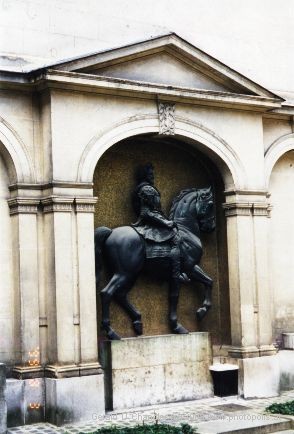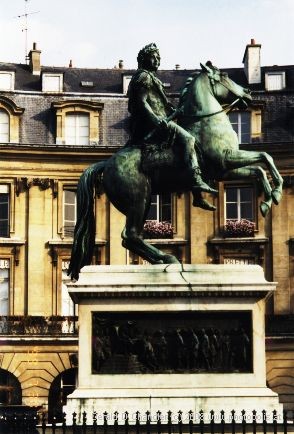Home | Front Page | Index | Blog | New | Contact | Site Map
Paris 1999 | Maps | Pics Day-by-day
Tourism
Daily Life
71 Rue de La Mare
Belleville
Computers
Metro
Objets Trouvés
Events
Gerry's Sketch
Hen Party
Jan's Birthday
Tour de France
Outings
Outside Paris
Fontainebleau
Giverny & West
Solar Eclipse
Versailles
Paris 1999
Paris 2005
Paris 2007
France 2007
Paris 2008
France 2008

Britain 1999
Beijing 1999
China 1999
Hong Kong 1999
Vietnam 2000
China 2000
The Bourbon line ruled France from 1589 through 1792 — in other words, from nearly the start of the European settlement in the Americas until the French (and American) revolutions. What might be called the start of modern times. During this period many of the finest squares and plublic places in Paris were created. Through revolution and counter revolution statues and names came, went, and sometimes returned. But the basic architecture of some jewels remained largely unchanged.
There were five Bourbon kings, one Henry and four Louis. Their names and the years in which they reigned are:
- Henri IV, 1589-1610
- Louis XIII, 1610-1643
- Louis XIV, 1643-1715
- Louis XV, 1715-1774
- Louis XVI,1774-1789
As you would expect, the French revolution being long over and Parisians being interested in their past and wanting to attract tourists, there are statutes of these fellows scattered about the city. However, their statues are not necessarily found at the place with which they are most closely associated.

Henri IV |
Henri IV can be found on horseback in one of the courtyards of the Musée Carnavalet, now the museum of the history of Paris. Henri IV has little association with this spot; the house was started in 1548 and passed through many hands and underwent many changes through about 1700.
Another statue of Henri IV, sited equally inappropriately, sits at the western (downstream) end of the Ile de la Cite, at the mid-point of the Pont Neuf. Nearby is the Place Dauphine, a tranquil green, named for the future Louis XIII. The land for it was given by Henry IV in 1607.
We are hoping to get back to the Place Dauphine to eat before we leave Paris. It seems to have little or no through traffic, several restaurants to choose from, and a wonderfully peaceful ambiance just a short walk from the hubbub of the square in front of Notre Dame.
Louis XIII sits on horseback in the Place des Vosges, which was started by Henri IV in about 1605. It is true that it was finished in the reign of Louis XIII in 1612. The original name of the Place des Vosges was Place Royale; that went with the revolution, which gave the new name in honor of the first department to pay its taxes.
The park that surrounds the statue is very pleasant with lots of benches
to sit on, and even the lawn is not out of bounds to visitors. The
square of course has lots of restaurants around it and one or two hotels
tucked away in courtyards that we found very appealing.

Louis XIII
|

Louis XIV
|
Some developers who wanted to get on the good side of Louis XIV proposed the creation of a square containing his statue. The result, in 1685, was Place des Victoires, a harmonious circle. The statue is appropriate, but is not the original, which, as might be expected, was melted down by the revolutionary government about 130 years after its placement. The current statue, the third in line, dates from 1822, also a period when royalty was "in".
Another statue of Louis XIV can be found in one of the courtyards of the Musée Carnavalet.
The circle itself has undergone changes since it was first constructed. We learned about its history from a walking tour we joined during our second week here. An interesting fact is that the developers (including the King and his family) first built the facades of all the buldings around the circle. They then sold the rights to build homes behind the facades to the public. The minimum purchase was the width of two arcades (you can just see some arcades in the bottom left of the photo). Unfortunately, control of the facades was not maintained continuously, so not all of the original ones survive. In modern-day Paris, of course, changes to these buildings are strictly controlled once more.
Someday we mean to write about Louis XV and Louis XVI.